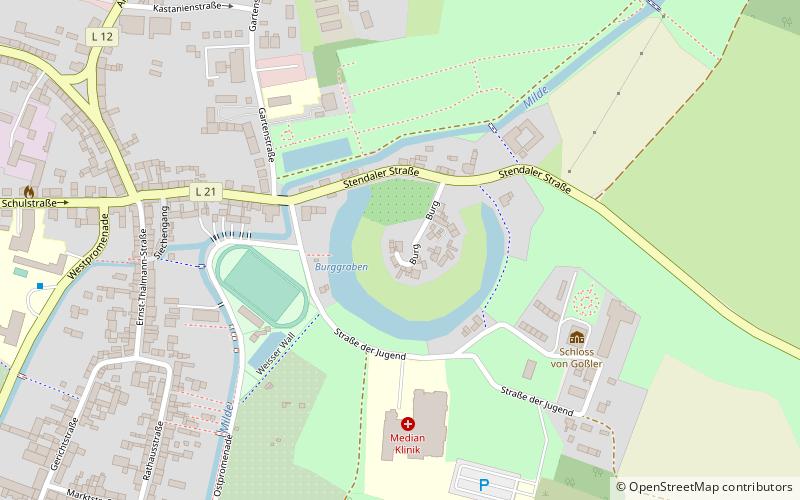Burg Kalbe, Kalbe


Facts and practical information
Kalbe Castle, formerly spelled Calbe, is the ruins of a moated castle between two arms of the Milde River in the urban area of the town of Kalbe in the Altmarkkreis Salzwedel district of Saxony-Anhalt, Germany.
The moated castle was built in the 10th century as a Saxon border fortress against the Wends, probably on the site of a Slavic rampart castle in the marshy area of the Milde. A nunnery founded in its protection, which the Obotrits devastated in 983, existed here until 1121. The castle belonged to the four Old-Marchan Burgwarden, which administered sovereign court and defense districts, along with Tangermünde Castle, Osterburg and Arneburg. These protected the Frankish colonized area and the mission monasteries between the Elbe and Milde rivers.
The castle was well protected from attackers by three moats and four forts and entrenchments. It gave its name to the noble family of Kalben from the Mark Brandenburg, which is mentioned in documents in 1207 in connection with the castle, where they were ministerial servants. At the end of June 1240, the castle was destroyed in the Teltow War and the Magdeburg War, when Margrave Johann I of Brandenburg laid siege to the complex, where the wounded Archbishop of Magdeburg, Wilbrand von Käfernburg, had taken refuge with the remnants of his faithful after the heavy defeat of June 24 at the Battle of the Biese.
In 1300, the Kröcher family became feudatories. After the extinction of the Brandenburg Ascanians, the Guelphs took over the Altmark and in 1324 enfeoffed the noble family of Alvensleben, which had bought the dominion from the Kröcher, with the castle. The Alvensleben family expanded the castle, which was in ruins at the time, into the largest castle in the Altmark; water was brought in from the Milde River via dams to fill newly dug moats. Thus the Calbe Werder with all its villages was transformed into a fortified island defended by outer works. The extensive earthworks and waterworks represented a significant technical achievement. In connection with the secured city and the outer works, the fortress offered space for larger army heaps, whose provisioning was secured by co-protected pasture and arable land, mills and villages. Only a large siege ring was able to enclose Calbe.
Kalbe and Bismark were mediat cities and, until the Prussian reforms at the beginning of the 19th century, judicial districts of the lords of the castle, who also owned property in 73 villages until the 18th century. The Calbe dominion was a joint condominium of several lines of the von Alvensleben family, who jointly appointed a commander at the castle. In 1479 the castle was renewed for the last time. In 1631, during the Thirty Years' War, the walls and ramparts were razed, the castle fell into ruin; the dominion remained and in 1795 became the sole property of the Alvensleben family at Neugattersleben Castle.
The former castle complex on a marshy horst of the Kalbeschen Werder had a castle area with a diameter of 360 meters and was still clearly recognizable in the terrain in 1584. In 1903, the castle ruins were restored by the von Alvensleben family so that they did not deteriorate further. The castle owners were expropriated in 1945. Today, ruins of the chapel, the gate and the residential house are still preserved. The castle is protected as a historic monument.
Kalbe
